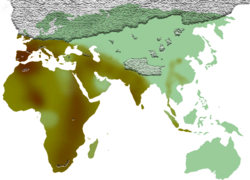- Movius Line
-
The Movius Line is a theoretical line drawn across northern India first proposed by the American archaeologist Hallam L. Movius in 1948 to demonstrate a technological difference between the early prehistoric tool technologies of the east and west of the Old World.
Movius had noticed that assemblages of palaeolithic stone tools from sites east of northern India never contained handaxes and tended to be characterised by less formal implements known as chopping tools. These were sometimes as extensively worked as the Acheulean tools from further west but could not be described as true handaxes. Movius then drew a line on a map of India to show where the difference occurred, dividing the tools of Africa, Europe and Western and Southern Asia from those of Eastern and Southeastern Asia.
Fossil evidence also suggests a difference in the evolutionary development of the people who made the two different tool types across the Movius Line and it has remained in use as a convenient distinction between the two traditions. The existence of the line, both in terms of stone tool technology and human evolution has needed to be explained.
Theories to explain the existence of the Movius Line include the idea that perhaps the ancestors of the toolmakers who settled in eastern Asia left Africa before the handaxe was developed. Alternatively the settlers moving to Asia may have known how to make handaxes but passed through a 'technological bottleneck', that is a region where suitable materials to make them were lacking. The skills were thus forgotten and isolation by distance meant that the knowledge was never re-introduced.
An alternate theory states that rather than stone axes, early humans in east Asia used bamboo tools instead.
Exceptions
At first, New archaeologic evidence from Jeongok-ri, South Korea shows that there are also handaxe in eastern Asia.
New archaeologic evidence from Baise, China shows that there are also handaxe in eastern Asia.
Bibliography
- Scarre, C (ed), The Human Past, Thames and Hudson, London, 2005 ISBN 0-500-28531-4
- http://www.anthropology.hawaii.edu/People/Faculty/Bae/pdfs/2010_Lycett%20and%20Bae_WA.pdf
Categories:
Wikimedia Foundation. 2010.

